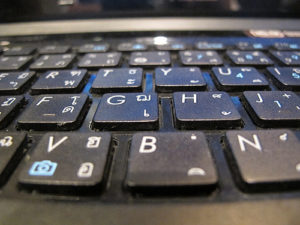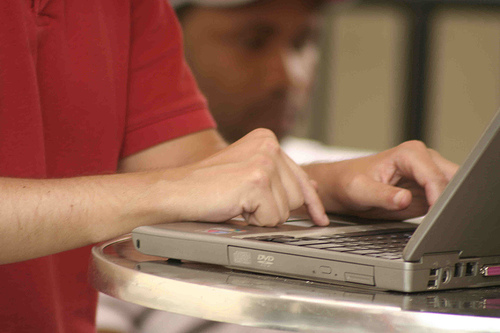
Photo Credit: Elvert Barnes (Creative Commons)
The Old-School Version of Tweeting
In 1979, my fourth grade class was rocked by a major note-passing scandal.

Photo Credit: Sorcyress (Creative Commons)
Back then, we wrote notes with the same frequency and flair that girls now text, tweet, Instagram, and SnapChat. The delivery system could be a problem, however, as notes could be intercepted by observant nuns.
Sister Paula had eyes in the back of her habit. One day, she caught some girls passing mean notes about other classmates and informed all the parents at a school meeting.
Mom may not have known about the Internet back then, but she certainly knew about a huge Digital Age’s problem: sending without thinking.
She sat me down and said:
Never write anything you wouldn’t want to see again.
Written words are permanent in a way that spoken ones aren’t. If you wouldn’t feel good about it later, don’t write it.”
Unlike what I did with most of her wise advice, I listened – and committed it to memory.
It’s become my mindful emailing mantra.
Caught in the Moment

Photo Credit: nist6ss (Creative Commons)
A few weeks ago, I banged out an extremely terse email to a colleague after she caused a firestorm on our team, hurting the feelings of a highly respected, hard-working friend and colleague.
I was tired, angry, and annoyed.
Jane’s behavior was neither professional nor productive, and it was costing us precious time and energy.
As I was about to click send, I paused, remembering my mom’s advice.
Step Away from the Keyboard
I put my hands in my lap and took a few deep breaths. I could see in my body just how tense I was – my left shoulder was so wound up it hit my earlobe.
Hmm…
If I sent that email, I’d perpetuate the kind of behavior that had me so hot in the first place. Even worse, I’d be helping that negativity ripple out far past the two of us as the situation worsened. Just as emails can go viral, so can emotions. That’s the last thing our team needed.
I got centered, trying (not entirely successfully) to relax. I thought of Jane’s situation – job transition, huge uncertainty, tight timelines – and likely a whole slew of other things I knew nothing about.
Then I thought about why she’d say what she’d said. While it was possible she did it to be mean, it was unlikely. Maybe she’d misunderstood. Maybe she was taking out her anger and frustration from other things. Or maybe she was just trying to get attention.
I have no idea what she was really thinking or feeling. Honestly, it didn’t really matter.
What did matter was that in less than a minute, I’d calmed down a bit and saw the situation much differently.
Send to Sender
I sent the email – but not to Jane. I sent it to myself.
When the message appeared in my inbox, I tried my best to read it as Jane would.
It was harsh.

Photo Credit: marsmet53 (Creative Commons)
I sounded like a major bitch. Of the Ice Queen variety.
If I were Jane, receiving this would make me feel offended, angry, and even further disregarded and misunderstood.
Most of all, to my mom’s point, I certainly didn’t feel good about sending something like that.
My self-righteous anger quickly dissolved into shame.
I’d never want to receive this email, no matter what I may or may not have done to provoke it.
I hit delete.
Email Minefield
We all know the potential perils of email.
Our little fingers go rogue, hijacked by emotion that feels deliciously justified in the moment but that often morphs into something more like regret, within seconds – especially if our heated mistakes get shared with the world.
We forget the recipient is actually human, just like we are.
We lack the critical nonverbal communication cues like facial expression, tone of voice, and body language. (Emoticons are a pathetic substitute.)
We read between the lines.
It’s a minefield – and what’s the best way to cross a minefield?
Don’t do it at all, if there’s any possible way to avoid it.
Sometimes emails don’t require and/or merit a response. Delete it – or toss it in a folder if you think you’ll need it later. Then do your work to let it go.
If you do need to cross the minefield, it’s best done veeeery caaaarefuuuullly.
To make it to the other side of a dispute without blowing everyone to smithereens, mindful emailing is, by far, the most effective way to navigate.
Mindful Emailing Starts with Presence and Awareness
Get present by taking several deep, slow breaths.
Identify what you’re feeling and where it most affects your body. Are your stomach, jaw or shoulders tense? Blood pressure elevated? Fists balled up like a prize fighter?
Acknowledge all of this without feeding into it – and step away from the keyboard. The situation is what it is – and how you feel about it will change with time, like everything else. Wait until you’ve calmed down, even if it takes a day or two.
When you’re ready to write, spend a moment thinking about how you’d like this email to be received.
What do you want the outcome to be?
What do you want the recipient to think of you when he or she reads it?
Your answer will likely be much different later than in the heat of the moment, so sit with it awhile.
Write From a Mindful Place

Photo Credit: Amarand Agasi (Creative Commons)
If you believe that an email response (as opposed to no response or direct conversation) is necessary, once you’re calm and clear, write the email.
Own your point of view by maintaining an “I” perspective (as in “I felt angry” vs. “You screwed up”).
Send the email to yourself. This is key to mindful emailing. In addition to catching missed typos, it’s much easier to take the recipient’s perspective when you literally receive the email in your inbox.
Read the email at least twice – from the recipient’s point of view. Connect their potential feelings, reactions, and responses.
Edit liberally. Make it clear and concise. Rephrase or delete anything that sounds like an attack, is off your main point, contains poor grammar, or could be misconstrued. While this doesn’t guarantee it’ll be interpreted as you intend, it helps a lot.
Send the email with clear intentions that it be well received and help to improve the situation and relationship.
Choose Your Words Carefully
Today, many of us write much more than we ever used to, perhaps more than we talk. (I don’t – I talk a lot.)
We are responsible for every single one of our words – even if we can’t control whether they’re shared, saved, or twisted.
If you want your words to speak well of you as a person, practice mindful emailing: hit the pause button before the send one.
My mom would like that.


WOW…one of the best posts that I have read in a long time! We have all written those emails and I’m sure most of us have been very sorry that they were sent. One thing I have learned to do is never put who it is to until I am done writing the email. Many times by the time I have finished I have gotten whatever it is off my chest and the email can be deleted – with no accidentally sending it. Love the idea too of sending it to yourself. Reading out loud is very powerful as well.
This can however be true for all other social media as well. Perhaps if people thought just a bit more of how their words actually sound they would be a bit more careful in what they post..
Again, thank you for a wonderful, thoughtful post.
Thanks, Kendra! I love your ideas of not putting the person’s name in the who and of reading it out loud. Not having their name would prevent me from doing something impulsive, and reading it out loud is a powerful way to really hear the message I’m sending.
Yes, it’s definitely true of all social media. If we took a little stroll through our Twitter or FB feed, I wonder what percentage of posts we could identify as impulsively written rants. I’m just glad all I had was note-writing in grade school and not all this instantaneous and rapidly shareable forms of communication because I had a lot less in the way of filtering practice back then, that’s for sure! 🙂
Another way to look at email mindfully is to ask:
By sending this email am I simply moving something from my to-do list to someone else’s to-do list? If yes, picking up the phone or having a face to face conversation might be a faster way to get things done.
So true, Kristy! I think there’s probably a lot of to-do list shifting going on. And so much is lost in email – over 90% of communication is nonverbal, and that’s all lost on the keyboard. I always find more gets done much more quickly with a quick face-to-face.
We have all written those emails and felt the regret – eventually if not right away. It is so true that so much gets lost in an email or text message. Words without the non verbal cues are not able to form a complete communicative picture and it’s easy some times to forget that there is a real person with feelings on the other side who is taking it all in.
Your mom is a smart lady who had some good advice. It’s wonderful that you are sharing it on. It’s something we all need to be reminded of. Slow down and think about the person/ people involved.
Kate, it is so true about how easy it can be to forget there’s a person on the other end with feelings just like I have. I shudder to think of what it’d be like to grow up now, when cyber-bullying is so huge for this very reason. It’s about remembering the other person, as you say. Thanks!
I really like how you emailed the email to yourself. What an interesting way to take a new perspective. I know for myself I read into every line of emails so I never send emails I’ve written from a place of anger or frustration. If I have to send something I write it, then walk away for a bit, come back edit, assess, take sometime to go over it. Everything on the internet last forever and just like your mom said never write anything you wouldn’t want to read again. Great Post Mary Beth!
Thanks, Melissa! I find I read the email differently when it’s in my own inbox and then I open it as the reader instead of the writer – it helps give me that shift in perspective to wake up and do some serious editing (or delete it and do my own work on why I wrote that in the first place…..).
Oh absolutefreakinglutley! That is so right! I think the same also for Facebook and Twitter, so many update with little thought as to why they are writing it, who it can affect and if it is actually even something that is of use to someone else or even to themselves! Writing from that mindset is not sensoring yourself but more from the sense of mindfulness (like you said). Thank you for the reminder I do love it that your mums voice is still there telling you what you already know 🙂
Thanks, Paula – I’ll have to pass that on to my mom, as she will greatly appreciate hearing that I did actually listen and follow her advice, even when I said I never did as a kid! 🙂 Yes – totally agree that social media posts run the risk of having little thought behind them. I’ve posted some rants on FB where, when I looked at them later, I cringed that people actually saw that. Most were kind enough not to point out what an idiot I appeared to be, but surely they must have been wondering what the heck was up with me that day…
Your mom gave some brilliant advice! I can’t tell you how many times I’ve sent some form of electronic communication and then later wished I hadn’t. I really like your encouragement to write from a mindful place. Sending an email to myself is also such a great idea. I loved how you sent the email to yourself instead of Jane and read it as if you were her. This is such a great lesson for me. This is a really well written and thoughtful article. Thank you so much for sharing your mom’s wisdom. It applies more today than ever.
Thanks so much, Michael! There’s something about changing my perspective from writer to reader that helps immensely. Someone else said she never puts the recipient’s name in the email until she’s re-read it and taken time to think about it – so she doesn’t accidentally hit send. I like that, too. With our rapid-fire digital world, it’s on us to make sure that what we put out there represents the person we are and want to be. But it’s definitely a huge challenge…